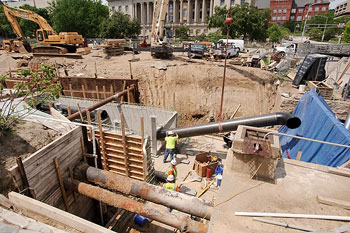Campus utility reconstruction: Short-term hassle buys long-term benefit
The construction site at the north end of Charter Street provides a graphic view of the complex upgrade of campus underground utilities that pedestrians and drivers have been dodging at various other campus locations for years.

Workers guide a 24-inch-diameter section of pipe as it is lowered by crane into an underground-utility construction site on Library Mall on June 14, 2011. The pipe will supply increased chilled-water service to the eastern portion of campus and is part of a long-term, campuswide upgrade of utilities intended to improve reliability and energy efficiency.
Photo: Jeff Miller
As welders piece together 10-inch steel pipe, the concrete pit about 20 feet below them holds sub-assemblies awaiting final assembly.
The pit, like its twin across the intersection, will hold two key components of UW–Madison’s elaborate utility system: piping for steam (which heats campus buildings) and the condensate that forms as the steam cools. After both pits are finished, their pipes and valves will be connected to each other and nearby buildings. Then contractors must fill the holes, replace a number of other utility lines, and repave the street.
And all this must happen before Aug. 15, says Dan Dudley, the campus utilities engineer with Facilities Planning and Management. Dudley does not have to explain how the hustle and bustle of move-in day would be aggravated if trenches and barricades are blocking a key intersection.
The Charter Street construction is part of the ongoing project to replace the underground utilities that pretty much everybody – outside of campus facilities experts — takes for granted.
The campus has seen a number of utility projects in recent years and months. Another highly visible utility project is also currently underway on the Library Mall.
Replacing utilities without shutting down parts of campus is a gnarly task, since most campus buildings need about twice as many utility connections as a house: Cables bring electricity and data. Pipes supply drinking water, chilled water for air-conditioning, steam for heat, compressed air to operate air ducts, and often natural gas. Other pipes remove sewage, storm water and condensed steam.
And although the campus physical plant is not responsible for all utilities, every bit of the system is buried, and therefore it makes sense to replace everything at once, says John Harrod, the retiring director of Physical Plant.
Physical Plant employs 65 people in generating steam and electricity, and 150 on the distribution side, including many steamfitters and electricians. Four miles of expensive, walk-through underground tunnels are on campus; to save money, planners now opt for the smaller “box conduits,” with access points every 300 feet.
In response to the 2005 campus master plan, the utility upgrade has been spending roughly $20 million to $25 million per biennium on a project that will continue for at least another six years, Harrod says.
“We looked at what we would need. How would we grow the utility system to support new demands from new buildings?” he asks.
Although rebuilding the Charter Street steam plant has absorbed a lot of attention, “We also focused on the distribution network, which had gone untouched for years and years,” says Harrod. “We are getting a much better handle on upgrading the system for greater reliability, backup and redundancy, which gives us more confidence in our ability to serve our buildings.”
During the 95-degree weather in late May, Harrod adds, “We were able to keep everything operational, even though we were past the design limit. This is the biggest utility upgrade in campus history, and we are in much better shape now in terms of reliability. Any time you can avoid trouble calls, there’s a savings.”
The project has also addressed weaknesses like the single steam line that supplied the hospital. “This line was showing its age,” Harrod says, “and we needed to have a backup for the hospital, which has now been installed.”
Overall, the project will improve reliability, reduce energy consumption, and improve comfort in some older buildings that cannot simultaneously receive chilled water and steam, and therefore cannot accommodate a cold spell after the heat is turned off. Few residence halls have chilled water and central air conditioning, which has come into demand as summer programs gain popularity.
Although the planners aim to minimize dislocations, “Surprises can happen any time you put a shovel in the ground,” Harrod acknowledges. “We do all the modern testing, but sure enough, we find an old storm sewer or sanitary line we did not know about and could not detect from the surface.”
Last summer, for example, diggers unearthed a box conduit holding electrical equipment at the intersection of Park and Langdon streets, Dudley says. “We called around, and MG&E had a retired engineer who remembered that they had abandoned a box conduit in that location. We took it out. Our policy is not to abandon old equipment. We remove it,” he adds.
We had to ask Harrod how he responds to the inevitable complaints about traffic dislocations.
“We work closely with Transportation Services to re-route traffic, but we know this has an impact on campus. We need to do this work. We try to get in and get out as quickly as we can, do everything at the same time, and let people go about their lives. There’s no other way to bring the campus into the 21st century.”



